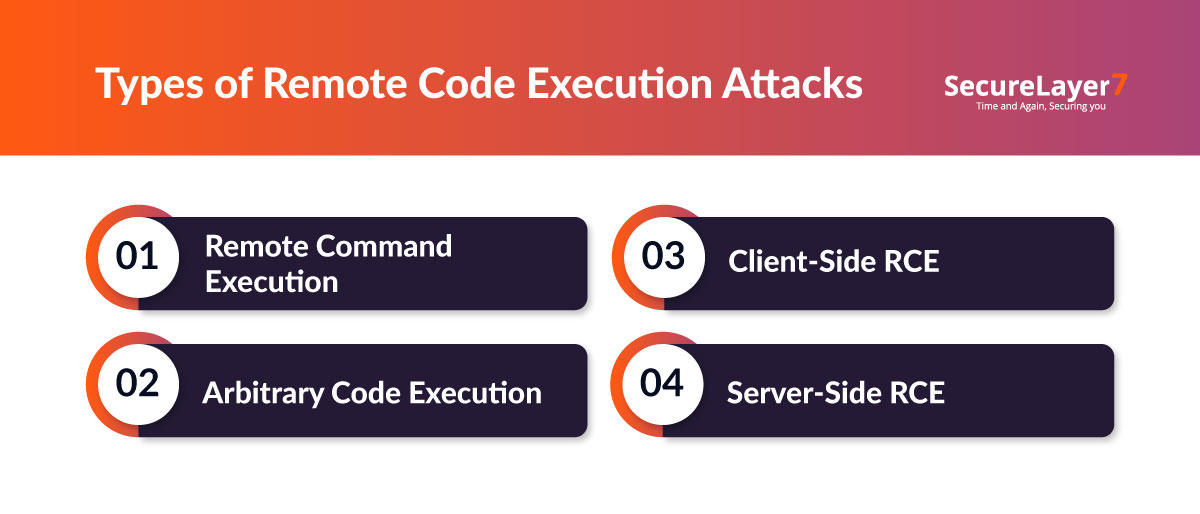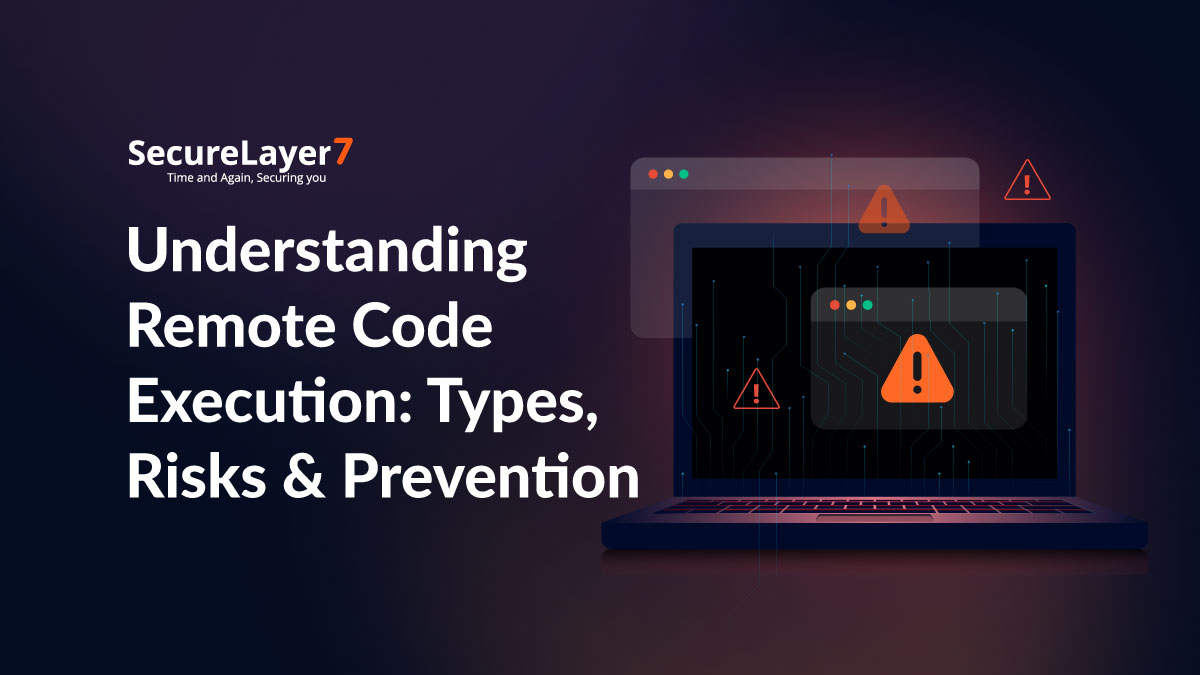In the world of cybersecurity, not all vulnerabilities are equal. Some of them are more dangerous and one of them is Remote Code Execution (RCE). It is the kind of vulnerability that lets an attacker run malicious code on your system without even being there physically. All they need is a way in and suddenly, your data, applications, and server could be in their control.
RCE attacks are serious because they give hackers the same level of access as a trusted user or admin. From stealing sensitive data to deploying ransomware or completely taking over a system, the possibilities are endless.
That’s why understanding what remote code execution is, how it happens, and how to prevent it is so important. In this blog, we will understand what RCE means, how attackers exploit it, and how you can keep your systems safe.
What is Remote Code Execution (RCE)?
Remote Code Execution (RCE) is a security vulnerability that allows attackers to run code of their choice on a target machine from anywhere.
When a web application or system does not properly validate user inputs or handle data securely, attackers can exploit that flaw to inject and execute malicious code remotely.
It’s often confused with Remote Command Execution, but there is a subtle difference.
- Remote Code Execution lets an attacker run code. They can upload scripts, exploit memory flaws, or install malware.
- Remote Command Execution, on the other hand, allows the attacker to run system commands (like those in a terminal or shell).
So, while both are dangerous, RCE gives attackers much more control. It’s not just about executing commands – it’s about taking over.
Inside Remote Code Execution Vulnerabilities
Every RCE attack begins with a weakness in the system. A vulnerability that gives attackers the opportunity to run code remotely. RCE vulnerabilities usually come from insecure coding practices or overlooked configuration issues, especially in growing web apps and APIs.
Here’s what usually leads to Remote Code Execution vulnerabilities:
1. Improper Input Validation: When applications accept user input without any filter or validation, malicious data can slip through and get executed.
2. Unsafe Deserialization: If an application blindly trusts serialized objects from users, attackers can modify that data to trigger code execution.
3. Insecure or Outdated Components: Libraries, packages, or frameworks that are unpatched often become an easy entry point for attackers.
4. Misconfigurations in Server or Cloud Setups: Even small mistakes like incorrect access rules or exposed admin tools can open the door for remote code execution (RCE).
Understanding why these vulnerabilities occur is a key step toward reducing the risk. The fewer blind spots in your application, the harder it becomes for hackers to gain control.
How Remote Code Execution Attacks Work
RCE attacks don’t happen instantly. Attackers follow a process to break in. Knowing how these attacks execute RCE helps security teams detect and stop them early.
RCE attacks usually follow a few key stages:
- Finding the Vulnerability: Attackers start by scanning for weak spots like unvalidated input fields, exposed APIs, or outdated libraries.
- Delivering the Payload: Once a vulnerability is found, a malicious payload (code snippet, script, or request) is sent to the target system.
- Executing the Code: The system processes the malicious input – unknowingly running the injected code.
- Privilege Escalation & Takeover: After execution, attackers often escalate privileges to gain full administrative access, moving deeper into the network.
Each stage gives a chance to stop the attack, which is why visibility and early detection matters so much. If you can detect unusual behaviour at Steps 2 or 3, you prevent Step 4 where the real damage begins.
Moreover, it is necessary to understand the difference between an RCE exploit and an RCE attack.
- An RCE exploit is the method or code used to trigger the vulnerability.
- An RCE attack is the full operation, where the exploit is used to gain control or cause damage.
Types of Remote Code Execution Attacks

Not all RCE attacks look the same. Depending on the target and technique, attackers may use different approaches. RCE attacks are not always launched to crash systems or steal data. RCE attacks can appear in different forms depending on where and how they are executed:
- Remote Command Execution: Runs specific system commands directly on the target device. Attackers run commands to explore the system and gather intelligence.
- Arbitrary Code Execution: Injects custom malicious code (scripts or binaries) to get access. Attackers drop full scripts or programs into the environment. These could install ransomware, crypto-miners, or persistence backdoors.
- Client-Side RCE: Exploit vulnerabilities in browsers or plugins to target end users. Here, attackers wait for users to click a link or open a compromised file. A single action can trigger a full-blown compromise.
- Server-Side RCE: Attacks backend servers, APIs, or cloud systems to compromise entire infrastructures. While client-side issues can affect individuals, server-side RCE has the potential to compromise an entire organization and make it the most dangerous form.
Understanding which type of RCE you are facing helps determine how to respond.
Risks and Consequences of RCE Exploits
When an attacker successfully executes remote code, they are not just running a program, they rewrite the rules inside your digital environment. When an RCE vulnerability is exploited, the damage can go far beyond a system:
- Complete System Compromise: Attackers gain full control over servers or networks. Hackers can become virtual administrators.
- Data Breach or Destruction: Sensitive data can be stolen, altered, or deleted.
- Malware and Ransomware: Attackers can install ransomware, crypto-miners, or backdoors. Attackers often use RCE as a first step to launch high-impact malware campaigns.
- Long-Term Persistence: Hidden access points allow attackers to stay undetected for weeks or months. They quietly install backdoors and wait until the organization is most vulnerable.
- Financial and Compliance Damage: RCE can lead to regulatory penalties and loss of customer trust. A single breach can trigger penalties, lawsuits, and a loss of trust that takes years to rebuild.
In short, RCE gives attackers keys to the organisation. And once they are inside, they decide the rules.
Detecting Remote Code Execution Vulnerabilities
Detecting RCE vulnerabilities early can make all the difference. Attackers try hard to make their activity appear normal. So, it is essential to detect or notice what doesn’t feel right.
Here is how security teams do it:
- Automated Testing Tools: Tools like DAST, SAST, or IAST scan applications for unsafe code execution patterns. Automated testing tools help catch insecure code paths that may lead to code execution.
- Manual Penetration Testing: Ethical hackers simulate real-world attacks to uncover RCE risks before attackers do.
- Behaviour Monitoring: Unusual spikes in CPU usage, unexplained processes, or outbound connections can indicate RCE attempts.
- Bug Bounty Programs: Encouraging external researchers to responsibly disclose RCE vulnerabilities helps organizations stay ahead. Bug bounty programs allow security researchers to report hidden RCE flaws responsibly.
The key is continuous visibility because RCE vulnerabilities can surface at any stage of development or deployment.
How to Prevent Remote Code Execution Attacks
You cannot stop every hacker out there, but you can make your systems much safer and harder to break into.
Here are some important tips to help prevent RCE attacks:
- Strong Input Validation and Sanitization: Never trust user inputs. Filter, validate, and escape them.
- Regular Patching and Dependency Updates: Keep all frameworks, libraries, and APIs updated. RCE vulnerabilities are often published publicly, and attackers simply take advantage when organizations delay updates.
- Least Privilege Execution: Limit execution permissions and isolate critical components. If a vulnerability does get exploited, minimal permissions help reduce the damage.
- Use Web Application Firewalls (WAFs): Block known attack patterns before they reach your app. WAFs identify malicious payloads and block them before they ever reach your application.
- Adopt a Secure Development Lifecycle: Integrate security testing at every stage of development.
Security is not a destination – it’s a continuous improvement cycle. Organizations that take RCE seriously strengthen their overall security posture in the process.
Real-World Examples of RCE Attacks
Real-world examples remind us how dangerous RCE vulnerabilities can be. They are often unnoticed until exploited. Attackers gain full control over systems, applications, or even entire networks. Let’s look at two major RCE incidents that left a lasting mark on the cybersecurity world and reminded everyone how critical timely patching and vigilance really are.
1. Log4Shell (Apache Log4j)
In late 2021, security researchers uncovered a critical RCE flaw (CVE-2021-44228) in Apache Log4j, a popular open-source logging library used in countless Java applications. A simple malicious string inserted into logs could force servers to download and run attacker-controlled code.
What made Log4Shell so dangerous?
- Log4j was everywhere – in cloud apps, enterprise tools, and consumer devices
- It scored a CVSS 10/10 – the highest severity rating
- Attackers used it to install ransomware, steal data, and hijack servers
Organizations worldwide rushed to find and patch every vulnerable instance. Even today, many remain undiscovered because Log4j is deeply embedded in software supply chains. Log4Shell proved that a small, overlooked component can expose millions to massive risk.
2. Microsoft Exchange ProxyLogon
In early 2021, multiple vulnerabilities known as ProxyLogon were exploited in Microsoft Exchange Server. These flaws allowed attackers to bypass authentication and execute code remotely, giving them full access to corporate email and sensitive data.
The impact was significant:
- Thousands of organizations were compromised globally
- Attackers installed web shells for persistent control
- Critical communication channels were exposed to espionage and data theft
This incident highlighted how one unpatched vulnerability in a core business system can quickly escalate into a widespread breach.
The Future of RCE Threats
Attackers are evolving fast. With AI-driven automation, hackers can now find and exploit vulnerabilities faster than ever, leaving organizations racing to patch before damage occurs. Even a small misconfiguration can become a gateway for a serious breach.
While threats are evolving, so are defences. The key to staying ahead is continuous monitoring, regular patching, and a proactive security mindset. Organizations that treat RCE threats as an ongoing challenge – not a one-time fix – are the ones that remain secure in the long run.
Conclusion
Remote Code Execution remains one of the most dangerous and disruptive vulnerabilities in cybersecurity. The impact of a single unpatched RCE flaw can cascade across networks, applications, and users. Organizations must focus on secure coding, quick patching, and regular penetration testing to stay protected. Prevention is always easier and cheaper than recovery.
Get in touch with our team today to assess, detect, and eliminate RCE vulnerabilities before attackers find them.
Frequently Asked Questions (FAQs)
RCE allows running any malicious code, while remote command execution focuses on executing system commands.
Mostly poor input validation, insecure deserialization, and outdated libraries or APIs.
An RCE attack happens when an attacker successfully exploits a vulnerability to execute code remotely.
It’s the actual method or code used to trigger the RCE vulnerability.
By using automated security testing, regular patching, input validation, and secure coding practices.
Because it gives attackers full control over the system, leading to data loss, ransomware, or complete compromise.


